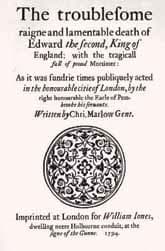Edward II
Critique • Quotes
 Title page of 1594 edition
Title page of 1594 editionOriginal title
The Troublesome Reign and Lamentable Death of Edward the Second, King of England, with the Tragical Fall of Proud Mortimer
First performed
1592
First publication
1594
Literature form
Play
Genres
Tragedy
Writing language
English
Author's country
England
Length
Five acts, approx. 3,100 lines, approx. 25,000 words
Love's labours punished
It can be difficult to read Edward II today as a Christopher Marlow play. One keeps sliding into thinking of it as minor Shakespeare—you know, all those early plays with kings and numerals in their titles.
Partly this is a matter of timing. We may appreciate Marlowe's own earlier plays, especially Tamburlaine and Dr. Faustus, in their own lights. Shakespeare the actor and novice playwright no doubt himself followed Marlowe's rising star in London theatre in those days. But by 1592 the Stratfordian was making a name for himself and had already matched Marlowe's output. Marlowe's new work then was about an English king in the same centuries-long line of succession leading up to their time that Shakespeare was plundering for narratives.
So Marlowe's Edward II fits right in with Shakespeare's three Henry VI plays and Richard II, which had likely already hit the stage, and the two-part Henry IV, plus Henry V and Richard III, to come. It's hard not to rank it with those and, when you do, it comes in somewhere between Shakespeare's lesser histories and the later masterworks in the series.
The one Shakespearean play it's best compared to though may be King John, which focuses on historical events four centuries earlier. Edward II deals with events three centuries before the playwrights' time. Both the kings, John and Edward, had ruled far enough in the past that they provided politically safe material for theatre. Both monarchs had been unpopular, both plays initially published with titles beginning "The Troublesome Reign...."
Implied sexuality
Both plays are largely expository, each condensing two decade's history into dramatic action that appears to span only a few seasons. Each focuses on the king's fight with a jealous nobility, conflating that fight with conflicts against the church. Each lays blame for the discord on the king's character, nonetheless showing his aristocratic enemies to be a scheming, disloyal, self-interested lot.
But Marlowe's Edward II has in modern times proven to be more intriguing to a modern audience—probably due to its reputation for sex and violence. Not explicit sex, mind you, nor even the romantic horniness of many an Elizabethan play. Rather the suggestion of the love that dared not speak its name.
For what is seen as lifting Edward II into the realm of great tragedy is the particular alleged fault that leads to the protagonist's downfall: he loves one man above all other men and women.
Edward's relationship with Gaveston, a childhood friend he raises into the peerage after he inherits the crown, can be—and has been—interpreted by actors as one of either intense friendship or homosexual love. Interestingly, Marlowe's text doesn't really spell this out. Edward's French-born queen speaks jealously of the attention Edward gives his friend instead of her. The various earls and barons are outraged at his raising of his favourite into, and above, their ranks. But no one even hints he engages in strange or unnatural acts.
Their criticism is for his violation of the social and political order, as they saw it, not for supposedly sinful personal behaviour. The issue is never the king's sexuality. Even gay interpretations of Edward II—which are valid—cannot make coming out of the royal closet the play's theme.
Moreover, Gaveston is removed halfway through the play, killed offstage by the king's enemies. And though he is suitably outraged and swears vengeance, we can't help but find Edward's response oddly even-tempered. He mourns the loss but with none of the heavens-falling, mind-bereft histrionics of Shakespeare's tragic characters.
Horrific violence
In one of the narrative's many turnabouts, the king has his revenge, winning a battle and taking the heads of defeated rebels. But he also replaces Gaveston with some new favourites, the sycophantic Spencer clan, who help him alienate the nobles into revolt all over again.
Not until near the end of Act IV when the king and his allies are in hiding, regretting their lives and envying the peaceful monastic existence of monks, do we start to get a feeling for the human being who's borne the crown. The final act featuring Edward's capture, squalid imprisonment and horrific death—with its overtly sexual implication—turns up the sympathy even more strongly.
In one last upset in the final scene, the king's death is also avenged. More bloody heads tossed about. So many characters, so many reversals in so short a span, so many plots and murders to track—and the human story peeping out here and there.
Scholars have said Edward II represents an advance in Marlowe's writing. His dramatic poetry has greater flexibility of metre than his earlier plays and reaches new heights of naturalistic dialogue.
This may be so. It does make for workmanlike lines that are easy to follow, which modern readers may find a relief. But to these eyes and ears, it still reads somewhat flatly, compared to the denser poetic flights associated with—you know—Shakespeare.
— Eric
Critique • Quotes

